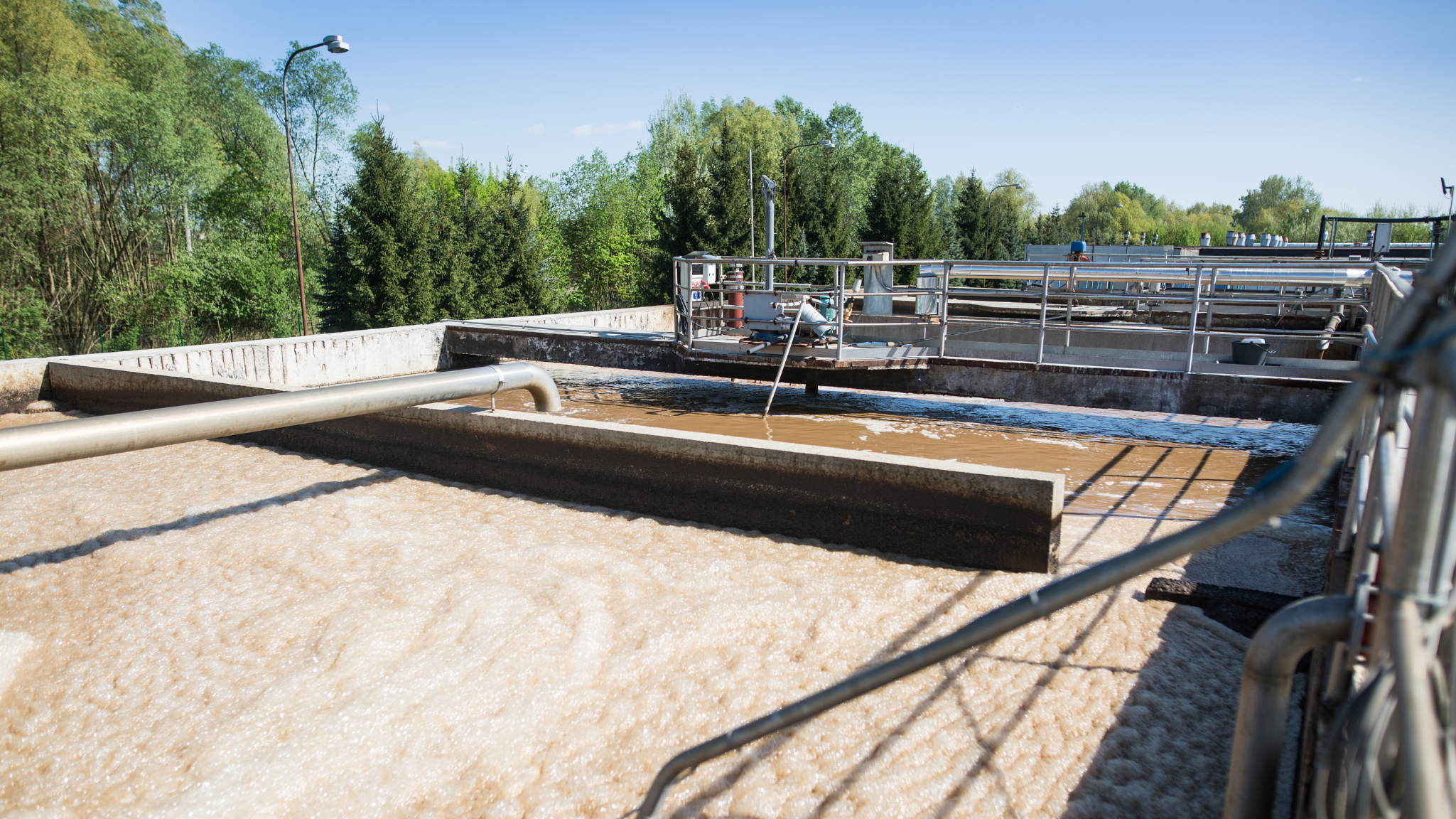In industrial and municipal wastewater treatment, solid-liquid separation is one of the most important steps. At the heart of this process is the polymer flocculant—a specialized chemical designed to bind suspended solids and transform them into larger, more easily removable particles. But not all flocculants are created equal, and using the wrong one can lead to poor sludge characteristics, excessive chemical usage, or even permit violations.
At ETI, we approach polymer flocculant selection as both a science and an art. With decades of experience in the water treatment industry, our team of chemical blenders formulates precision polymer solutions based on the specific characteristics of each waste stream. Whether a system is handling oily industrial effluent, biological sludge, or mixed solids from a food processing plant, the right polymer flocculant for wastewater treatment can make or break performance.
This article explores the key differences in polymer chemistries, explains how ETI matches polymers to water treatment goals, and outlines the critical role flocculants play in overall wastewater system efficiency.
Why Flocculants Matter in Wastewater Treatment
In every wastewater treatment system, the ability to remove suspended solids efficiently is essential to protecting downstream equipment, meeting discharge standards, and optimizing sludge handling. While initial solids removal may start with screens or clarifiers, the process called flocculation is what enables fine particles to clump into larger, settleable masses that can be removed through sedimentation or filtration.
Flocculants work by promoting particle agglomeration during the coagulation and flocculation phase of treatment. As smaller particles suspended in water interact with coagulants, they form micro floc. Once flocculants are introduced, these micro floc grow into larger flocs with stronger internal bonding, improving settling velocity and dewatering characteristics. Without a well-designed flocculation step, particles often remain suspended in the liquid phase, leading to turbid effluent, excessive sludge, or both.
Flocculants also help reduce the overall chemical burden on a system. By improving solid-liquid separation efficiency, they allow facilities to operate with fewer chemical additives, lower energy demands for sludge processing, and improved filtration cycles. From clarifiers to centrifuges, the right flocculant improves every downstream component’s performance.
Understanding Polymer Chemistry: Cationic vs Anionic Flocculants
Flocculants used in wastewater treatment are typically long-chain synthetic polymers designed to bring suspended particles together during the flocculation process. The key to success lies in selecting the right type of polymer chemistry—primarily cationic or anionic—based on the characteristics of the waste stream.
Cationic Polymers for Negatively Charged Particles
Cationic flocculants carry a positive charge, making them effective at targeting and neutralizing negatively charged particles commonly found in biological sludge, paper mill effluent, and municipal wastewater. These polymers rapidly destabilize fine particles, encouraging them to agglomerate into denser floc that settles or dewaters efficiently.
ETI uses a range of high molecular weight and medium-charge density cationic polymers to support rapid settling and efficient sludge handling. Our long polymer chains and strong hydrogen bonding capacity help form large flocs even under challenging water conditions.
Anionic Polymers for Positively Charged or Neutral Particles
Anionic polymers, carrying a negative charge, are most effective in treating systems where positive charge dominates. This includes mineral-rich wastewater, inorganic coagulant byproducts like metal hydroxide precipitates, and streams treated with iron salts or aluminium sulfate.
These polymers excel in improving performance after coagulants and flocculants are introduced, especially in heavy industrial applications like mining, metal finishing, and lime softening. Low molecular weight anionic polymers may be selected for delicate solids separation, while high molecular weight versions are used when forming large flocs for mechanical sludge dewatering.
Key Factors That Influence Polymer Flocculant Performance
| Factor | What It Affects | Why It Matters |
|---|---|---|
| Molecular Weight | Floc size, settling rate, sludge compaction | Higher molecular weight helps form larger, faster-settling flocs; lower weight is used for fine control. |
| Charge Density | Particle binding efficiency, compatibility with coagulants | Determines how strongly the polymer interacts with suspended solids or residual ions in the water. |
| Polymer Chain Length | Bridging capability, floc strength | Longer chains improve particle bridging and help form stable, cohesive flocs. |
| pH Range | Polymer solubility, reaction efficiency | Some polymers perform best within specific pH ranges; performance may drop outside those parameters. |
| Liquid Phase Temperature | Viscosity, dissolution rate, reactivity | Warmer or cooler water may affect polymer behavior, especially with powder makedown. |
| Suspended Solids Concentration | Dose requirement, mixing efficiency | Systems with high solids loads may require stronger or more targeted polymers for effective treatment. |
How Coagulants Influence Polymer Performance
In many wastewater treatment systems, flocculants are added after coagulants initiate a chemical reaction that destabilizes suspended particles. Inorganic coagulants like ferric chloride, aluminium sulfate, sodium aluminate, and ferrous sulphate introduce metal salts that reduce the surface charge of colloidal particles. This step is crucial for beginning the aggregation process. Organic coagulants may also be used when a system requires fewer solids or lower sludge production.
Flocculants then build on that initial reaction. Once coagulants have agglomerated particles into micro floc, polymers complete the process by forming larger particles or denser floc that can be easily removed. The wrong pairing, such as using an anionic polymer with incompatible iron salts can reduce efficiency or create excess sludge.
The Chemical Blender’s Role: Matching Polymer to Process
In wastewater treatment, selecting the right flocculant is not just about choosing a polymer with the right charge. It’s about aligning chemistry with the full context of the treatment process. At ETI, we treat polymer flocculant selection as an engineering decision, not a sales choice. Every formulation we recommend is based on the specific properties of the waste stream, the performance goals of the facility, and the design of the water treatment system itself.
Waste Stream Analysis Comes First
Before recommending any product, our team begins with a thorough evaluation of the waste stream. We analyze particle charge, pH, suspended solids concentration, and the presence of co-treatments like inorganic or organic coagulants. We also assess how solids are currently removed—whether through dissolved air flotation, sedimentation, or mechanical dewatering—because each process interacts differently with polymer performance.
Powder vs Liquid Flocculants: Format Matters
Once the appropriate polymer chemistry is identified, the next step is choosing the right delivery format.
Powder flocculants offer benefits like extended shelf life, reduced storage space, and precise dosing flexibility. They are ideal for facilities that treat large volumes of wastewater or need maximum efficiency at the lowest possible cost per gallon treated.
Liquid flocculants, on the other hand, are pre-dissolved and ready for immediate use. These are best for systems that require rapid deployment, minimal labor input, or simplified operations. They are commonly used for emergency response, batch treatment, or smaller systems where powder makedown is impractical.
Tailored Blending for Specific System Conditions
Every wastewater treatment process has unique dynamics, and those conditions determine how a polymer behaves. ETI blends polymers based on factors like:
- Sludge type and density
- pH range
- Water temperature
- Existing coagulant chemistry
- Desired floc strength and settling speed
Whether the goal is to improve clarity, enhance dewatering, or reduce chemical use, the formulation must match the system.
Industry-Specific Considerations for Polymer Flocculants
No two wastewater streams are the same, and that’s especially true across different industries. Each sector generates unique combinations of suspended solids, organic material, and chemical byproducts—making a one-size-fits-all approach to flocculant selection ineffective. At ETI, we develop polymer formulations that are not only charge- and weight-matched but also tailored to specific industry requirements and discharge conditions.
Municipal Wastewater Treatment
In municipal systems, consistency and compliance are key. These facilities handle high biological loads with varying solids profiles and require flocculants that perform reliably during both primary and secondary clarification stages.
ETI supplies high molecular weight cationic polymers to improve biomass settling and reduce carryover into tertiary systems. Our solutions also enhance performance in sludge dewatering units like belt filter presses and centrifuges—helping municipalities reduce hauling costs and maintain clean effluent.
Industrial Manufacturing
Industrial facilities face more variable challenges, often dealing with complex chemistries and mixed contaminants. From metal finishing operations with iron salts and heavy metals to textile wastewater full of fine particles, the need for targeted flocculant chemistry is critical.
Our team formulates flocculants with precise charge density and polymer chain properties to ensure compatibility with upstream coagulants and downstream equipment. Our approach supports improved solid-liquid separation and better process reliability.
Food and Beverage Processing
Food production wastewater typically contains high levels of organic material, oils, and greases. These require flocculants that can bind particles suspended in emulsions or warm process water without generating excessive sludge.
We supply flocculants engineered for color removal, grease capture, and enhanced performance in dissolved air flotation (DAF) systems. These polymers maintain performance even with hot water discharge and help meet strict effluent regulations.
Commercial and Light Industrial Systems
Not every facility handles large volumes of wastewater, but smaller operations still need effective treatment. Car washes, commercial laundries, and food service operations deal with surfactants, sludge, and suspended particles that can be difficult to settle.
Our company offers powder flocculants and ready-to-use liquids that deliver reliable results with simplified dosing. Our lightweight, easy-to-handle products ensure performance without overcomplicating system operation.
Avoiding Common Mistakes in Flocculant Selection
Even experienced operators can run into performance issues when polymer flocculants aren’t properly matched to the system. Understanding common pitfalls can help avoid wasted resources, unexpected maintenance, and inconsistent treatment outcomes.
Relying Too Heavily on Charge Type
One of the most frequent mistakes is assuming that identifying a waste stream’s surface charge is enough to choose the right polymer. While selecting between cationic and anionic polymers is a starting point, it doesn’t account for important variables like molecular weight, polymer chain structure, or the presence of other treatment chemicals. These factors all influence how well a flocculant performs in different operational settings.
Ignoring Chemical Interactions
Flocculants rarely work alone. In many systems, they follow a coagulation process involving inorganic coagulants such as ferric chloride, sodium aluminate, or aluminium sulfate. If the chosen polymer interacts poorly with these compounds, it can destabilize the system. Problems may include poor floc formation, increased sludge volume, or even re-suspension of solids.
Compatibility with other additives is especially important in facilities using blended chemical programs or operating under strict discharge requirements. Unintended reactions can reduce floc strength or create residual issues downstream in the filtration or sludge treatment stages.
Using a Static Formula in a Dynamic System
Many facilities change over time, whether due to seasonal flows, production shifts, or regulatory changes. Sticking with the same flocculant without periodically reassessing performance can lead to diminishing returns. A polymer that worked well last year may no longer deliver maximum efficiency under new operating conditions.
Conducting jar tests, reviewing sludge behavior, and staying responsive to process changes is essential for long-term success.
Choose the Right Chemistry, Not Just the Right Charge
Selecting a polymerflocculant for wastewater treatment isn’t just about choosing between cationic or anionic types. It’s about understanding how that polymer will behave in your specific system under your conditions — with your contaminants, and alongside your existing treatment chemistry.
By evaluating factors like suspended solids, charge density, coagulant interaction, and molecular weight, treatment professionals can make informed decisions that improve performance, reduce chemical consumption, and support long-term system health.
If your facility is ready to take a more tailored approach to flocculant selection, consult with formulation experts who understand both chemistry and performance.





